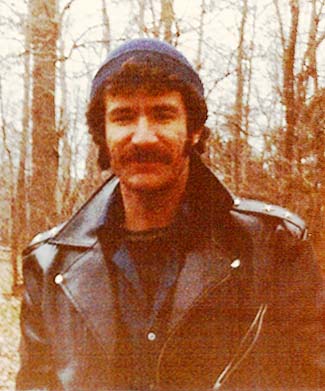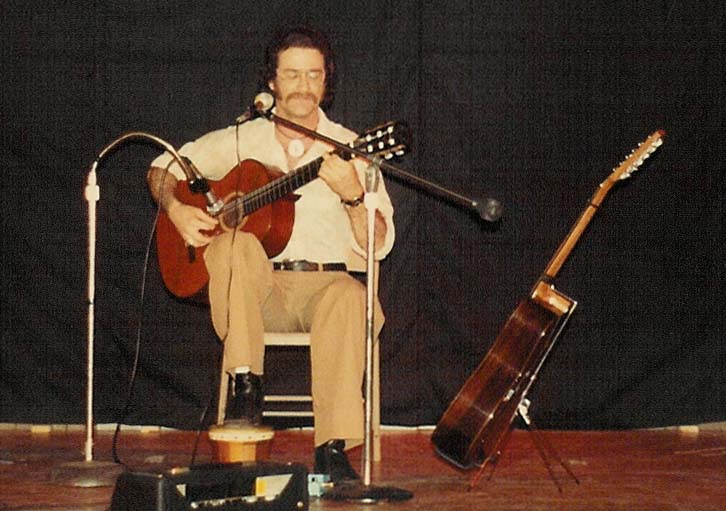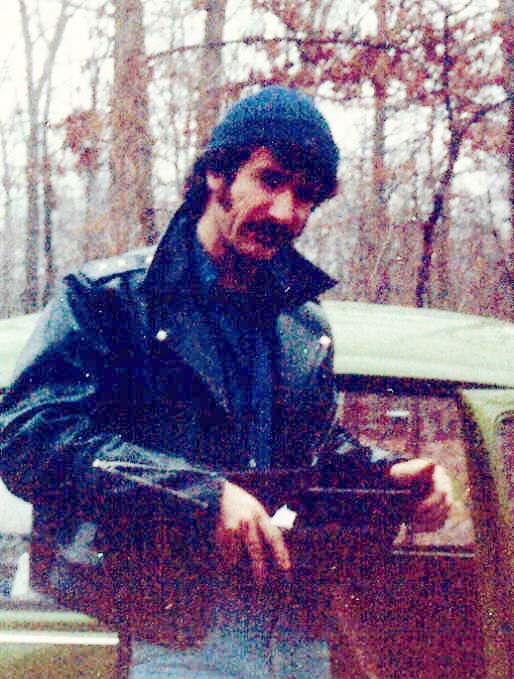
PHOTO: Kentucky 1981, around the time these
recordings were made. In fact, 14 of the songs in this Vol. 1 collection
(26 songs) were recorded 1979-1982.
General info on the 2-track
recordings: The majority of the songs in this collection
were recorded into my
simple Wards Airline,
Model 3669, two-track 7" reel-to-reel tape recorder
aided only by a Shure
Vocal MasterPA
unit for reverb. Ten of the songs, including Eye of a Hurricane, are recordings
circulated
to family and friends on gift cassette tapes in 1981 and 1982. In
order to get the most out of having only two
tracks,
I recorded guitar and voice through the same microphone onto one track
and then recorded guitar and voice onto the other track. This allowed
me to play the lead guitar part on the
second
track. Each take meant simultaneously
playing the guitar
and singing the vocals all the way through each song since there was no
overdubbing or mixing.
Sample song from this era Eye
of a Hurricane (2:42) ©1981; registered recording ©1982; two
acoustic guitars and two voices.
Inspiration for the lyrics: This song owes a lot to one of my all-time favorite rock bands, Jethro Tull, and the songs of Ian Anderson. Like many of my songs, it is primarily a guitar piece with lyrics added for something to sing. Although the lyrics are sung from the perspective of being  "in" the eye of a
hurricane it was more
like my own fantasy of a good place to be rather than any place that I
actually ever was. The lyrics were probably influenced by Jethro Tull songs such as Living in the Past and Skating Away. "in" the eye of a
hurricane it was more
like my own fantasy of a good place to be rather than any place that I
actually ever was. The lyrics were probably influenced by Jethro Tull songs such as Living in the Past and Skating Away. Inspiration for the music: The guitar was capo'd on fret 3 (such as in the Tull songs Skating Away and Thick as a Brick) raising the song to the Key of G minor instead of E minor as it would be without the capo. The guitar technique is essentially extremely fast down-up strokes played with a pick. Yes, it was recorded exactly as fast as heard here. After 30 years, though, I now play this song without a capo and much slower to match my lower and slower voice. Other influences for the guitar part include heavy metal from bands popular in 1981-82 so much so that one of my friends called the style, "heavy wood," because it was played on an acoustic guitar rather than the standard electric guitar of most heavy metal. One of the guitar parts is essentially "power chords" (parallel 5ths in classical terms) like used in most heavy metal. Finally, apart from the obvious Tull influence other influences included bluegrass (especially the vocal effect I always liked of obscuring the consonant at the end of a sung phrase), a little Van Halen, and a little jazz.  The speed aspect probably came
from bluegrass and the fact that a couple of my former roommates were into
speed guitar. One of my roommates had a
fully-amplified rock band in the basement while I was learning the
quiet style of classical guitar. Sometimes, in those days, grabbing the
acoustic and
pounding away at 90 miles an hour with a flatpick was the best use of time. The speed aspect probably came
from bluegrass and the fact that a couple of my former roommates were into
speed guitar. One of my roommates had a
fully-amplified rock band in the basement while I was learning the
quiet style of classical guitar. Sometimes, in those days, grabbing the
acoustic and
pounding away at 90 miles an hour with a flatpick was the best use of time.
Technical: This is another recording made on May 14 & 15, 1982. The guitar is a Conn 12-string which I restrung as a standard six-string acoustic. Like about 10-20 other songs from this era the recording was made using my simple consumer-grade Wards Airline tape recorder aided only by a Shure Vocal Master PA unit for reverb. An important thing to point out is that the song was recorded on only two tracks (rhythm guitar & voice on one track plus power chords, lead guitar, and voice on the other). Unlike in professional recordings, there was no overdubbing or mixing for punching in corrections or effects; even where it sounds like a voice echoes off electronically or a lead guitar part is mixed in, these effects were all done acoustically on the fly while recording; however, some tweaking of the wave file was done after conversion to digital format. Apart from EQ and stereo panning, there are a couple of things in this digital file which I hope to fix sometime soon. PHOTOS: Left; Kentucky 1981; Right, playing a different song at On Stage #7, May 9, 1981. Eye of a Hurricane was recorded using the guitar seen on the floorstand, a Conn 12-string restrung as a six. |
E-mail:
feliks (at) umich.edu
Last updated March 14, 2011. © John Feliks 2009